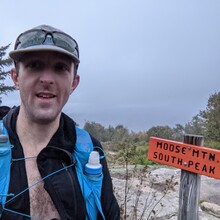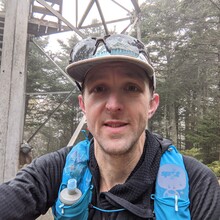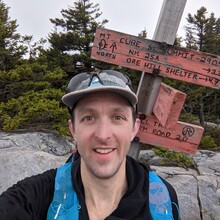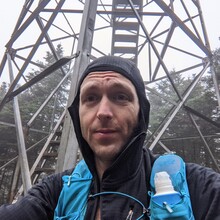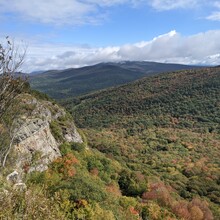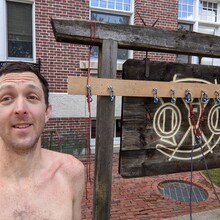Overview:
Over a week has passed since I set out to run the Dartmouth 50 out and back from the Dartmouth Outdoor Club on Dartmouth's Campus over Mount Moosilauke to the Ravine Lodge and back. In short, the effort was a success and it was an adventure.
The route covers about 102 miles with a bit over 30000 ft of elevation gain and is primarily on the Appalachian trail, with short bits on roads through Hanover, NH, and a several miles to the Ravine Lodge and back on Gorge Brook trail.
I ran unsupported, carrying everything I needed from start to finish, filtering water from streams. I communicated my location occasionally with a SPOT, and texted with my wife and father when I had cell service. This led my wife to send out a friend with food for me, because she knew I was extremely low on food. I did not ask for this assistance and denied it when I ran into my friend on the trail. He ran behind me chatting for a few minutes, presumably to make sure I was turning him down in a sane state, then let me continue running solo.
I started at 04:00:00 on Sept. 30, 2021, and finished at 15:51:42 on Oct. 1, 2021 for a time of 35:51:42 elapsed. I know of no other recorded times for this route by any style.
Detailed Trip Report:
Three years ago, I ran the one-way route from the DOC to the Ravine Lodge unsupported as a "big scary goal" and as my first 50+ mile effort. For a couple of years now, I've wanted to try a 100ish mile route that would be hard enough to take me through a night.
I finally committed myself to this route and these dates as it would end on my birthday, give me a good night of sleep to recover for my son's birthday, and a couple of days before returning to work.
Training went well: I practiced night running, some easy paces, a lot of vert, some family hikes, and several long runs a week for a short 5ish week block followed by a rather abrupt taper with a lot of much-needed rest.
I planned to run fully solo and unsupported. I estimated my times based on splits from other runs on the course, adding conservative buffers to keep paces easy, give myself time for water filtering at streams, and for performance degradation through the effort.
As the day came closer, the weather forecast went from perfect: partly sunny with highs about 60 F and lows about 48 F, to not-so-perfect. On the eve of my run, the forecast called for likely rain and socked-in summits with north winds approaching gale force, and temperatures not getting out of the 40s F on Thursday, but a little warmer and drier on Friday (when I was set to finish).
Consequently, I had to take more gear to mitigate the hypothermia risk: a rain jacket and pants, and a small puffy jacket to my running vest. This added substantial weight and bulk to my vest, and the many layer changes and fiddling certainly took time on course, but kept me warm.
I carried two BeFree water filters in some Hydrapak flasks that fit in a Solomon vests as well as two other soft flasks to fill with Tailwind. I had about 11000 Calories of food with me: granola bars, crackers, about 2200 Cal of Tailwind, and about 1000 Cal of home made energy gel, bite-sized candies, a chocolate bar, some trail mix, and a small package of cookies.
I parked at the Hanover Co-Op, and walked to the start at the DOC, arriving a few minutes before my intended start time of 4 am. I swung my legs to warm them up a little, then tapped the DOC sign and started my watch at 4:00:00 AM.
I had trouble settling in to the proper easy pace, and spent a lot of time looking at my heartrate on my watch trying to settle myself in the first few miles over Velvet Rocks and to Trescott Rd. I eventually found the right feel for the effort, and settled in, and also decided to try to smile at least once a mile. This was a bit of a silly thing to do, but I was grateful to have the opportunity to try it, and also, smiling improves running economy. I kept that up for the remainder of the run.
My first water filtering was slow and I realized that relying on some liquid calories would be time-consuming, and probably was a bad idea. That stop put me 10 minutes behind my target only 9 miles in at Moose Mountain South Peak.
I managed to mostly hold that gap until around Mt Cube, when rather than push, I eased off, having realized that I hadn't packed enough food.
I had been comfortably eating 400+ Cal/hr for the first 50k or so, but I had only planned for about 300 Cal-hr, and would certainly run out long before the end.
I began to limit intake. Fortunately, the terrain between Cube and Rt. 25 is fairly tame and I moved efficiently without consuming much.
Climbing the Glencliff trail up Mt. Moosilauke was agonizing trying to eat as little as possible.
I finally tagged the summit a couple of minutes before sunset in a cloud, having put on my rain pants, jacket, and mittens below treeline, which helped protect me from the 33 F, wet 20+ mph winds.
I made it down Gorge Brook Trail a fair way before having to switch on my waistlamp. It was too foggy to bother with a headlamp.
The rocks on Gorge Brook are still big and round and slick as I remember, and movement was slow, but I finally reached the Ravine Lodge, and walked around it and up to the awning next to the road where I ended my Dartmouth 50 one-way 3 years earlier in 15:47, about 1:15 slower than the one way 3 years earlier, but feeling far better.
I sat down at the bench by the road and took stock of my food. I had split food evenly between outbound and back legs, putting my food for the return trip in my bag, and carrying the outbound food in easily accessible pockets to try to minimize stoppage (but my poor choice of using liquid calories and filtering ruined that efficiency thoroughly). Though I had added another 1000 calories or so at the last minute, I had eaten all of that, all of my outbound food, and started dipping into homebound food already.
Nonetheless, I put all my food in easily accessible pockets, and prepared for the return trip. I knew I would have to ration food very substantially, or else call for a food drop/assistance to make it through...
I started my long trudge back up Moosilauke in the dark. There had been a few Dartmouth students around outside the Ravine Lodge, but I otherwise didn't see a soul on Moosilauke over or back. Again, below treeline, I put on my rain pants and shell and shell mittens and prepared myself to just move quickly to get over and back below treeline. I snapped a quick photo at the summit at 9:46 pm and continued on down the ridge, moving well. Nothing hurt, I wasn't too tired, just hungry.
That would be a theme. I ate very little down to Jeffer's Brook Shelter, where I took a little break and again took stock of my situation. After shedding some layers and getting ready for the next flatter segment, I was back on the move. But uphills slowed to a crawl without food, and I was very hungry, but knew that eating food now would mean I wouldn't have any at the end, when daylight would otherwise have me moving faster.
Going up past Wachipauka pond and over Mt Mist was a slow trudge, and I noticed that my heartrate was steadily falling. After calorie limiting over Moosilauke and back, I was finally running out of glycogen and the familiar dead legged feeling set in. The calorie deprivation also was making me sleepy. Somehow, I was still smiling at least once a mile!
I kept pushing on, and was still well able to jog the flats and downhills, but soon, even a 1% grade slowed me to a walk, and made my eyes droop. I started looking for flattish, dryish spots to stop for a dirt nap.
Eventually, just before 2 am, I found a nice spot next to the trail with lots of soft pine needles just after Tarleton Rd. and put on all my clothes (including the puffy I had carried but hadn't actually needed on Mt. Moosilauke), and lay down with my head on my pack, trusting cold as my alarm clock.
In my sleepy stupor, I must have hit buttons to stop and save my activity on my watch as I plugged it in to charge while I slept. I worried I had accidentally discarded the activity... Nonetheless, I had lay down to sleep, so I put my head down and gave it a go. Thought I didn't think it would be easy to sleep, thanks to caffienated gels, and the general excitement of the situation, I must have fallen asleep almost instantly.
About 40 minutes later, I shook awake, confused. I was shivering.
I got up, packed the puffy away, started a new activity, and got moving, warming fairly quickly. I felt slightly recharged, though groggy and sleepy still, but was again trotting the flats and downhills and having to walk uphills of almost any grade.
When I got to the base of Cube a little before 4 am, I knew I had about 50k to go, and since I had eaten almost nothing the preceding 15 miles, and had been calorie limiting before that, I would have enough food to make it to the finish. I expected to slow dramatically at this point, so I still felt I would have to limit food intake, but took a caffienated gel, filled a bottle of Tailwind, and ate a granola bar to fuel the ascent of Cube.
I tagged the summit of Cube at 5:27 am, and my waist light died shortly after. I could have shifted it to another battery, but knew that my headlamp would be enough for the remaining 30ish minutes until it was light enough that I didn't need additional lighting.
Starting up Smarts, I felt better having been eating a little more, and kept moving decently. At the summit of Smarts, I checked my phone to see that my wife, concerned about my calorie deficit had called for reinforcements and my buddy Jeremy had hopped on the trail with snacks to bring me. I sent her a text saying I didn't neep help, but knew it was too late, and that I would run into him on the trail, and have to tell him I didn't need any support. I didn't call for aid, and didn't feel I needed it, though when my wife went to sleep, things looked rough and I wasn't sure I'd make it, which is why she had called for help for me, while I was out of phone service.
Heading down Smarts, I moved more quickly than I had been all night, and eventually ran into my friend Jeremy. I immediately told him that I didn't need anything. He ran along behind me for a few minutes and chatted, but I made it clear that I didn't need or want help, and that I was still attempting to run unsupported. After a bit, he dropped back and let me move along.
I kept moving well to the base of Holt's Ledge, snagging a couple of small apples from a tree hanging over the trail. This is when I knew I had enough food to finish eating well, and went back to eating 400 Cal/hr.
All the same, it felt like I was dragging up Holt's, and barely managed a trot down the steeper sections of the downhill on the other side. When the terrain flattened out, I felt much better though, and managed something that might be considered running.
I knew that going up the climb up N. Moose Peak was my last substantial climb, and started to feel like I would definitely finish before dark. On S. Moose Peak, I ran into my colleague, out for a lunch run.
The terrain from here to Hanover was much mellower, and I managed to do some running again, though uphills continued to slow me to a not-very-fast hike.
Things seemed to be going well, and I didn't even feel all that terrible now that I was eating again. The last few miles are over Velvet Rocks, and the terrain gets steep and rocky, and slick, and uneven again. This slowed me again to a crawl, and the tendons in my left foot began to ache and that overwhelmingly became my concern as I plodded on.
On the final descent into Hanover, I realized I would probably make it in under 36 hours total, and started running again. After waiting for traffic lights, and stripping my shirt (intended for the 40s I had run in most of the time, not the first direct sun of the trip on asphalt and 60s F), I ran the streets of Hanover back to the DOC, touching the sign there at 3:51:42 PM, or 35:51:42 elapsed.
While I did run into two people I knew on trail, I did not intend to meet either of them, did not call for or seek help or receive assistance beyond a few words with those people when they were near me.
Takeaways and thoughts:
A week on and I've already forgotten much of the suffering, and it feels like it was a good experience overall. Perhaps that's largely because I really didn't have any problems physically until a little foot pain toward the very end, aside from insufficient food.
I'm sure that with another 4000-5000 Cal of food, I could have gone a couple of hours faster. I also think that my choice to use any liquid calories in conjunction with filtering water cost me over an hour. With slightly better weather (i.e. dryer at the same temps), I could have skipped the pants and puffy jacket and saved substantially on weight and bulk as well as time spent changing layers. Essentially, it feels as though this route could feasibly be done (perhaps even by me) in more like 30 hours, unsupported. Supported, even in these conditions, I think I could have gone under 30 hours on this day(s).
But for me, the purpose of the run and the style chosen were multifaceted: I wanted to experience what 100 miles on foot is like, and I wanted to do that in the purest way - alone, fully self-sufficient. The Dartmouth 100 has similar stats to some big-mountain ultra marathon races I have considered, so finishing this route with gnarlier trails fully unsupported gave me big confidence that I could go to one of those races and expect to do decently well (for me, not in an absolute sense).
I learned a lot from this. It really went absolutely remarkably well: I didn't suffer any of the typical 100-mile issues. I had no chaffing, significant joint pain, significant foot pain, issues with food intake or stomach, issues with hydration, cramps. My body functioned incredibly well, and somehow seemed matched for the terrain and distance both.
The big things I learned were about how I can keep going low and slow even without food, and about how much food I really need to keep going at a decent, but still easy effort for so long. It seems I can genuinely keep eating 400-450 Cal/hr without issue at these low intensities (HR below 140, mostly below 135 for me).
It also felt like a validation of my training philosophy here, which transitioned me from mostly flatter roadier training for time-efficiency to doing a 4-5 week intensive trail block with lots of elevation gain, and several 20+ mile runs a week, focusing on getting decent downhill stimulus in, and on testing gear, and systems (and doing night runs to see how that would work for me).
I'm glad I got this done, and that it went so seemingly well, though it was quite a bit slower than what I think I could do if I were a little more dialed. It was my first go at this kind of distance, or time on feet, nearly doubling my previous bests at both metrics.
This leads me to think I could do decently at this kind of ultra distance... so long as I bring lots of food!
I'm incredibly grateful to my wife for putting up with me talking about nothing else for 6 weeks, and for shouldering an unfair amount of house chores, and childcare as I prepared for and ran this route.
I was also grateful to those who have gotten me into the sport of running and particularly mountain and trail running, who have trained with me, and inspired and encouraged me. Too many to name, but I thought of many throughout the journey.
My sister-in-law got Courtney Dauwalter to record a video for me before this trip. It was amazing, if a little weird, and I appreciated it immensely and thought about it frequently on the trail. I also occasionally channeled Courtney's mantra: "This is fine. You're fine. Keep going."
Gear:
Topo MTN RACER shoes
Drymax socks
Compression Calf Sleeves
Salomon XA Shorts with stretchy waist pockets and hand pockets (so nice for stashing the snack you're currently working on)
Patagonia R1 hoodie
Naked Running Belt
Salomon Sense Pro 10 pack
Kogalla RA light with 20000 mAH battery + 10000 mAH backup battery (also used to charge watch)
Black Diamond Spot & 2 sets of backup batteries
SPOT locator beacon
2x BeFree filters mounted to Hydrapak 500 ml soft flasks that fit the threading and fit in Salomon packs well
2x Salomon soft flasks for Tailwind drinks
Hat
Sunglasses (useless)
Extra pair of socks
Patagonia Nanopuff
Patagonia Alpine Houdini jacket
REI rain pants
REI shell mittens
Black Diamond grid fleece gloves (amazing)
Black Diamond Carbon Distance Z poles
Trimmed down med kit including tape, Ace bandage, some blister repair items, some ibuprofen
Space blanket
18-hour hand warmer packet
Squirrel's Nut Butter
Mask, credit card, ID
Food:
~2200 Cal Tailwind unflavored
~1400 Cal homemade and other energy gels
~ 800 Cal candybar minis
~ 3000 Cal granola and other bars
~ 1300 Cal snack crackers
~ 400 Cal nut butters
~ 500 Cal dark chocolate bar (awful - way too high cocoa content for these purposes)
~ 500 Cal fruit strips
~ 800 Cal cookies
~ 600 Cal trail mix





